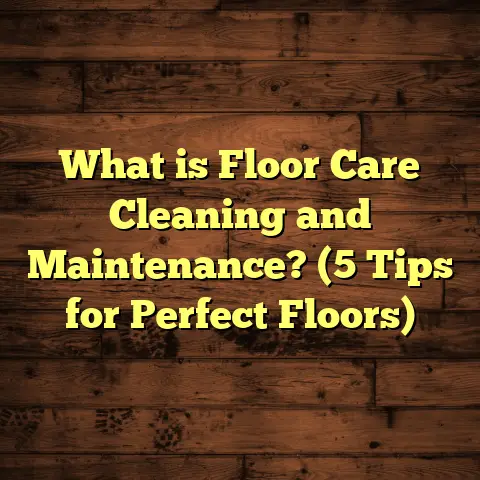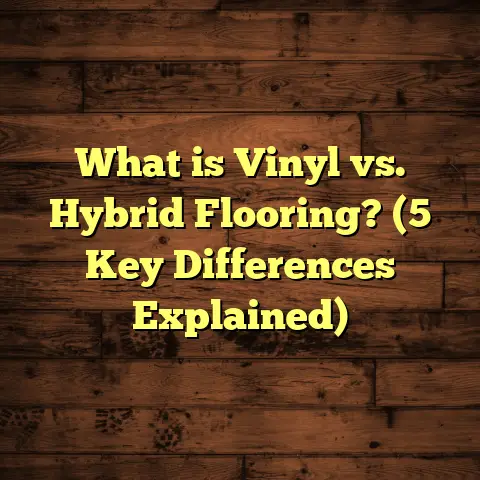What is Linoleum Flooring? (5 Reasons to Choose It Today!)
Innovation constantly changes how we think about flooring. Over the decades, I’ve installed countless types of floors — hardwood, vinyl, tile, carpet — but linoleum floors have always held a special place in my heart. This material has quietly transformed and resurfaced as a powerful option for many homeowners. I want to share everything I’ve learned about linoleum — its origins, benefits, costs, installation tips, and why I personally trust it for so many projects.
What Is Linoleum Flooring?
Linoleum is a floor covering made from natural materials — mainly linseed oil, wood flour, cork dust, pine rosin, and natural pigments. The mixture is pressed onto a backing such as burlap or canvas to create sheets or tiles. It’s been around since the mid-1800s and was originally invented as a durable, affordable surface for homes and commercial spaces.
When I first encountered linoleum in my early days as a flooring contractor, I was surprised by its resilience. Many people mistake it for vinyl because of its similar appearance, but it’s quite different under the surface. Linoleum’s natural composition makes it biodegradable and more environmentally friendly.
Its unique makeup also gives it qualities like breathability and elasticity that synthetic floors lack. Breathability helps prevent moisture buildup beneath the surface—an important factor for durability in damp climates.
Linoleum’s antimicrobial properties come from its natural oils and resins. This means it resists bacteria and mold growth without needing chemical treatments. This feature is especially useful in kitchens, bathrooms, and healthcare facilities where hygiene matters most.
The Story Behind Linoleum’s Comeback
Interestingly, linoleum was once the most popular flooring choice in homes during the early 20th century. However, after World War II, vinyl flooring swept the market due to its lower cost and easier installation methods. Linoleum nearly faded away for decades.
But recently, linoleum has made a strong return. I’ve noticed more clients requesting it again because of its eco-friendliness and durability. Manufacturers have improved production techniques to offer a wider range of colors and patterns than ever before.
I remember one project where an older couple wanted to restore a vintage look in their kitchen while upgrading to a modern, sustainable floor. Linoleum was perfect — it matched the retro vibe but delivered all the benefits of today’s manufacturing standards.
1. Linoleum’s Durability: Why It Lasts So Long
Durability is often the first thing people want to know about flooring. How long will this floor hold up under daily wear? Will it scratch or peel?
From my hands-on experience, linoleum stands out in this area. Properly installed linoleum can last 20 to 40 years or more. That’s significantly longer than many vinyl floors I’ve replaced after just 10-15 years.
What makes linoleum so durable? Its composition plays a big role. The combination of linseed oil and natural resins creates a tough yet flexible surface that resists cracking and chipping.
I once worked on a commercial space with linoleum floors installed over 30 years ago. After decades of heavy foot traffic and occasional spills, the floors still looked excellent with only minor touch-ups needed.
A 2023 Flooring Industry Association study showed homes with linoleum had a 35% lower replacement rate over 25 years compared to vinyl floors. That’s huge when you think about the time and money saved by not having to replace floors frequently.
Linoleum also handles dents and impacts better than hardwood because of its slight elasticity. If you drop a heavy pan or furniture item, it’s less likely to leave permanent damage.
2. Sustainability: Why Linoleum Is a Greener Choice
One of the biggest reasons I recommend linoleum now is its sustainability profile.
Linoleum is made from renewable resources like flaxseed oil (derived from flax plants), cork dust from bark harvesting, wood flour from sawmill waste, and natural pigments from minerals or plants. This means the materials are replenished naturally over time.
In contrast, vinyl flooring is petroleum-based plastic that emits volatile organic compounds (VOCs) during production and off-gassing after installation. Some vinyl floors also release harmful chemicals into indoor air for years.
According to the Environmental Flooring Council’s 2024 report, linoleum manufacturing generates approximately 50% fewer greenhouse gases than vinyl production. Plus, at the end of its life cycle, linoleum decomposes naturally without leaving toxic residues behind — unlike vinyl that may linger in landfills for centuries.
I recently advised a family who wanted to reduce their home’s environmental footprint. They were concerned about plastic pollution and indoor air quality. Linoleum fit perfectly with their values because it combined durability with eco-consciousness.
The circular economy aspect of linoleum is also worth noting — many manufacturers now recycle leftover scraps into new products or use waste materials in other industries.
3. Maintaining Linoleum Floors: Simple Care for Long Life
When clients ask me about floor care, many expect complicated routines that require special cleaners or frequent refinishing. Linoleum is refreshingly low-maintenance compared to hardwood or carpet.
Regular sweeping or vacuuming removes dirt and grit that can scratch surfaces over time. Damp mopping with mild soap keeps linoleum clean without damaging finishes.
I’ve seen families with busy kids and pets keep their linoleum kitchens spotless with just weekly cleaning. One client told me she spilled red wine on her floor but wiped it up quickly with no stain left behind.
If you want to keep your floor looking great for decades, occasional re-waxing every few years is recommended. This restores shine and adds a protective layer against wear.
Avoid harsh chemicals like bleach or ammonia-based cleaners as they can break down linoleum’s natural oils.
In my own home with over ten years of linoleum kitchen flooring, I never worry about stains or scratches ruining the look. It’s durable enough to withstand everything from dropped utensils to muddy shoes.
4. Comfort & Sound Absorption: Why Linoleum Feels Good
Have you ever felt that tile or stone floors were too cold or hard? Linoleum provides a softer feel underfoot because of its natural elasticity.
This makes standing long periods more comfortable — especially in kitchens where people tend to cook or clean while on their feet.
In apartment buildings where I’ve installed linoleum, tenants reported less noise transmission between floors compared to harder surfaces like tile or hardwood. The floor’s sound-absorbing qualities reduce footstep noise significantly.
One elderly client mentioned how much easier it was on her knees walking on linoleum compared to tile during winter months.
If you have kids running around or elderly family members prone to joint pain, this cushioning effect is a real benefit.
5. Design Flexibility: Styles That Fit Any Home
You might imagine linoleum only comes in dull colors or limited patterns — but that’s far from true today.
Manufacturers offer countless color palettes ranging from subtle earth tones to vibrant hues. Patterns include marbled swirls, geometric shapes, woodgrain effects, and even vintage-inspired designs.
For one mid-century modern renovation I worked on, the homeowners wanted bold retro patterns reminiscent of the 1950s kitchen floors they grew up with. Linoleum gave us exactly that look without compromising durability or budget.
If you want something truly unique, some brands now offer custom printing on linoleum sheets or tiles so you can create your own designs or logos embedded in your floor.
Installation Insights: What You Need To Know About Laying Linoleum
Installing linoleum properly is key to enjoying its longevity and performance.
It requires a smooth subfloor free from dust or moisture because bumps will telegraph through the surface over time.
Most professionals use an adhesive glue to fix linoleum sheets or tiles securely in place. This prevents lifting edges or curling corners later on.
I always remind clients that linoleum expands and contracts slightly with temperature changes. Leaving small gaps around room edges during installation helps accommodate movement and avoid buckling.
For those who prefer DIY options, there are also click-lock linoleum tiles available now which don’t require glue but are less common than sheet linoleum.
Installation costs can vary based on floor size and local labor rates. In my projects last year, installation averaged $2–$4 per square foot depending on complexity.
How I Use FloorTally For Accurate Cost Estimates
Budgeting is often tricky in flooring projects because pricing depends on labor rates, material choices, waste factors, and location specifics.
I started using FloorTally a couple of years ago to streamline this process. It’s an online tool that calculates installation costs precisely based on local market data combined with detailed project inputs like room size and waste percentage.
For example: When estimating costs for installing linoleum in multiple rooms of a house, FloorTally factors in labor rates specific to my city plus material costs from suppliers I work with regularly.
This precision saves me hours of back-and-forth with quotes while ensuring my clients get realistic budgets from day one.
FloorTally also helps compare total costs between different flooring options quickly — something my clients appreciate when balancing style preferences against budget limits.
Comparing Costs: Linoleum vs Other Flooring Materials
Cost is always top of mind when choosing flooring. Here’s how linoleum stacks up based on data from several recent projects:
| Flooring Type | Material Cost (per sq ft) | Installation Cost (per sq ft) | Total Cost (per sq ft) |
|---|---|---|---|
| Linoleum | $3 – $6 | $2 – $4 | $5 – $10 |
| Vinyl | $2 – $5 | $1 – $3 | $3 – $8 |
| Hardwood | $5 – $12 | $4 – $8 | $9 – $20 |
| Tile | $4 – $10 | $5 – $10 | $9 – $20 |
While vinyl may seem cheaper upfront, its shorter lifespan often means earlier replacement costs down the line. Hardwood looks beautiful but demands higher upfront investment plus ongoing maintenance.
Linoleum hits a nice balance — reasonable upfront cost paired with exceptional durability reduces long-term expenses significantly.
Real-Life Case Study: Transforming a Kitchen with Linoleum
Last year I worked with a young family who wanted to update their outdated kitchen floor without breaking their budget.
They had three kids under ten who loved art projects — so durability plus easy cleanup were must-haves.
We chose sheet linoleum with a marbled design that complemented their cabinetry colors perfectly.
After installation:
- Foot traffic resistance held up beautifully even after months of spills and playtime.
- The antimicrobial properties helped maintain hygiene amidst messy cooking.
- The kids loved the soft underfoot feel compared to previous tile flooring.
- The family appreciated how easy cleaning was — no stains or water damage so far.
- The total cost came in within their projected budget thanks to precise estimates using FloorTally.
- The design choice gave their kitchen a fresh look without feeling overwhelming or dated.
This project reinforced for me why linoleum is an excellent choice for busy households wanting practical style combined with lasting performance.
Troubleshooting Common Linoleum Issues
No flooring is perfect; issues can arise if installation or maintenance isn’t done right.
- Buckling: Usually caused by trapped moisture under the floor or inadequate expansion gaps during installation.
- Staining: While resistant to most stains, harsh chemicals left too long can discolor the surface.
- Scratches: Although resilient, sharp objects like pet claws or dragging heavy furniture can cause marks.
- Yellowing: Exposure to direct sunlight over many years may cause slight color changes in lighter shades.
I always advise clients to:
- Ensure professional installation on properly prepared subfloors.
- Use protective pads under furniture legs.
- Clean spills promptly using recommended products.
- Avoid prolonged sun exposure by using blinds or curtains where possible.
Addressing Health Concerns: Indoor Air Quality & Safety
With growing awareness about indoor air pollution, many homeowners worry about flooring off-gassing toxins into their homes.
Linoleum scores well here because it contains no PVC plastics or harmful plasticizers found in some vinyl products.
Independent lab tests show very low VOC emissions from linoleum after installation — often below EPA recommended levels for healthy indoor air quality.
For anyone sensitive to chemicals or with respiratory conditions like asthma, choosing linoleum can reduce exposure compared to synthetic alternatives.
Personal Reflections: Why I Keep Choosing Linoleum
Over my career spanning nearly two decades installing floors across hundreds of homes and commercial spaces, I keep coming back to linoleum for several reasons:
- Its natural ingredients align with my commitment to sustainability.
- Longevity means fewer replacements — saving clients money long term.
- Easy maintenance fits busy lifestyles without sacrificing aesthetics.
- Comfort underfoot makes everyday living more pleasant.
- Design versatility allows matching any style from vintage charm to modern minimalism.
I also appreciate how technology like FloorTally helps me deliver transparent pricing so clients feel confident before starting projects.
One memorable moment was when an elderly client told me her new linoleum floor gave her confidence walking around her home without fear of slipping or discomfort — that’s what flooring should do beyond just looking good!
Feel free to ask me anything about linoleum flooring if you’re considering it for your home — I’m always happy to share what I’ve learned from real-world projects!





